Category: Turkey Hunting
Nikon Monarch Binoculars Made My Season
My 2011 turkey season was one of the best I’ve had. It was one of those years where I just happened to be hunting in the right place at the right time on several occasions. I truly believe the success of many of those hunts would not have been possible without the help of my Nikon Monarch binoculars. This was the first year I turkey hunted with a high quality set of binoculars. They were especially helpful when I was hunting open country. I was able to watch birds from a distance and figure out which ones were gobblers and which direction they were headed. From this information I was able to formulate a plan and set up nearby. From there my Derby City slate calls did the rest. My Nikon binoculars and Derby City calls will be part of my turkey gear for my future turkey seasons, that’s for sure!
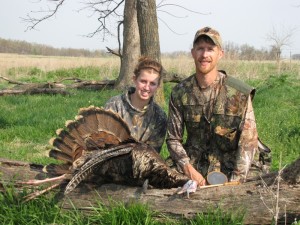
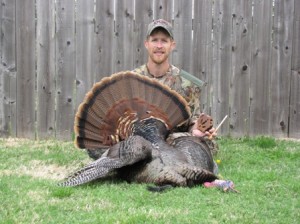
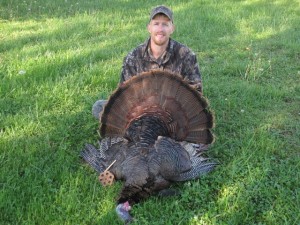
Growing Deer together,
Brad
Peak of Predation
Fawning and nesting season occurs at a great time of year. The temperatures are warming, and most vegetation is at its peak of both production and quality. It is the best time of year for deer, turkey, quail, and other game in many ways. It’s also the toughest time of year for these same species.
Coyotes and other predators are extremely skilled at consuming fawns, eggs, and poults. In fact, in many instances this is the time of year when losses to predation are at the highest. A coyote can kill multiple fawns. Several recent research projects have documented predators consuming 70+% of newborn fawns!! A single raccoon can destroy multiple turkey nests and consume dozens of eggs.
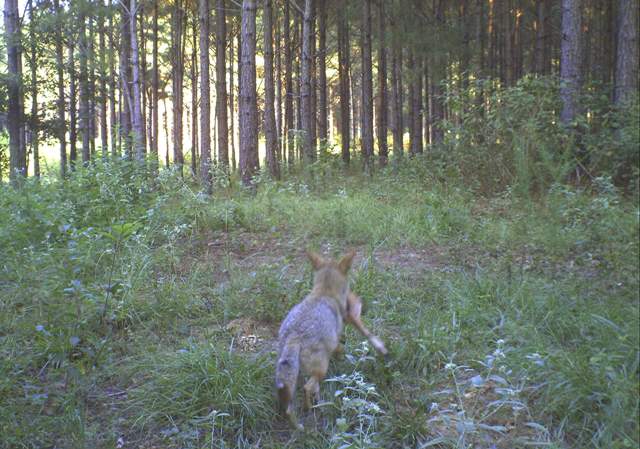
The old theory that as long as ample cover is available, predators are not a problem has been disproven by multiple well-designed research projects. However, hunters and managers should find encouragement in that significant increases (100+%) in fawn and poult survival have been reported in association with predator removal. These huge increases in fawn/poult survival are certainly enough evidence and motivation for me to practice predator control at The Proving Grounds and on my clients’ properties.
Calling coyotes is a great management tool and can be effective during the spring. Calling coyotes is one of the most enjoyable and exciting hunting techniques around. I can’t think of many activities that are better than an enjoyable hunt and knowing that I’m directly helping the local deer and turkey populations. I’ll be calling coyotes this spring so my family and I will continue to have quality hunting opportunities this fall. I hope you will join me in this important and fun wildlife management activity!
Growing Deer together,
Grant
Patience
Wild turkeys have had a low rate of nesting success during the past few years in portions of the Midwest. This is due to lots of rain during the nesting season and increased numbers of predators. There are still enough turkeys to hunt, but hunter success rates are decreasing.
This is not only because there are fewer gobblers compared to past years. A huge factor behind the declining hunter success rates is that there aren’t as many two year old gobblers present. Two year old toms tend to gobbler more than any other age class of gobblers. In addition, they tend to respond to calling by approaching rather than wait for the “hen” to come to them.
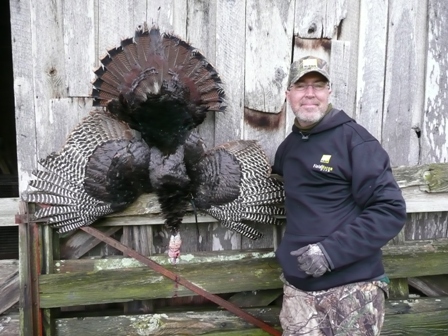 By contrast, three year old and older gobblers tend to gobble less and wait for hens to come to them. This is probably a predator defense tactic and given the increasing number of predators, this tactic may be used even more than during the past. It’s a simple matter of selection. Toms that gobble a lot and respond by approaching calling are harvested more frequently by predators and hunters than toms that wait for the hen to approach them.
By contrast, three year old and older gobblers tend to gobble less and wait for hens to come to them. This is probably a predator defense tactic and given the increasing number of predators, this tactic may be used even more than during the past. It’s a simple matter of selection. Toms that gobble a lot and respond by approaching calling are harvested more frequently by predators and hunters than toms that wait for the hen to approach them.
Because of this, it usually takes more patience and skill to harvest a three year old or older gobbler. I’ve been blessed to have had much success at harvesting three year old and older toms. My rate of success with these mature birds has increased as I’ve gotten older and I am less likely to move when a gobbler doesn’t approach my calling rapidly or stops gobbling.
I’m much more willing to call to a tom, get a response, then remain in place even if the tom doesn’t gobbler for an hour or more. Mature toms will certainly respond to and come to a call. However, they rarely run to a call while gobbling the entire way.
By getting a tom’s attention and remaining in an area where toms have been known to strut or frequent, mature gobblers will frequently approach without gobbling. The more patience I gain as I mature, the better a turkey hunter I’ve become. I’m still a huge fan of the cut and run turkey hunting technique. I simply don’t “run” as much as I did when I was younger. Less “running” has allowed me and my guests to put more turkey breast in the freezer.
A principle I was taught in college is that change is the only constant. The demographics of many turkey populations have changed and therefore it has been advantageous for me to change my hunting techniques. By combining biology and woodsmanship, I have plenty to eat besides tag soup!
Growing Deer together,
Grant
Learning from Harvested Critters!
Unless you manage land in an area where the primary land use is commercial ag production, it requires good food plots to produce forage and grain on a year round basis. The corn and soybean rotation in areas where the primary land use is commercial ag production provides a great diet for deer, turkey, and many other wild species. Even though these crops are harvested, the combines spill a bit of grain that provides high quality food through the winter.
However, as combines become more efficient, there is less and less spilled grain available for wildlife. This is why it’s important to plant specifically for wildlife in both areas with and without commercial ag production.
There have been four turkeys harvested so far during 2011 at The Proving Grounds. I checked the crop in three of these turkeys and each of them contained soybean grain! The last was yesterday when my 80 year old father harvested an adult gobbler. It was a thrilling hunt and the real trophy was the time spent with my father. The gobbler and video was a bonus. However, I always want to learn from the harvested critter as much as practical. I call this scouting from the skinning shed!
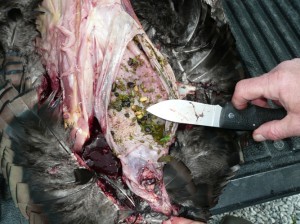
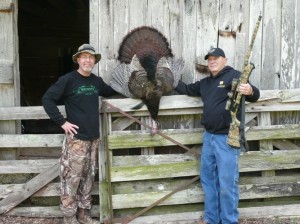
This goes beyond recording weight, spur length, and beard length. One of the most important sources of information from all harvested critters is what’s in their gut (or crop when talking about turkeys). Even though it’s late April and we’ll begin planting Eagle Seed soybeans soon, this turkey had soybeans in its crop. My father harvested this gobbler just after noon, so the crop wasn’t full (he had probably been chasing hens all morning) but it still contained soybeans.
Truly the Eagle Seed beans planted during April and May 2010 are still feeding wildlife at The Proving Grounds a year later. That’s an extreme value! Scouting from the skinning shed also provides me with more confidence on where I should take Tracy, my wife, hunting later this week.
The next time you harvest a critter don’t pass on the opportunity to learn about the local habitat and current hunting information. Sometimes the best scouting occurs without leaving the skinning shed.
Growing Deer together,
Grant
Year Round Food Plots: The Magic Bean!
I was part of a panel at a national convention years ago when a member of the audience asked each member of the panel what they thought was the “magic bean” for food plots. Each member of the panel except me offered a suggestion like clover, brassicas, peas, etc. I refused to answer. I agreed with my colleagues that each of the crops they mentioned had good characteristics, but each also had obvious limitations.
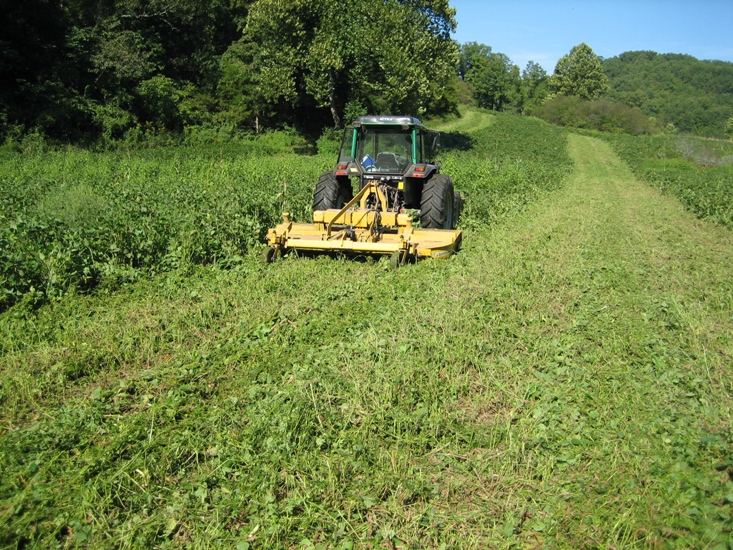 In the decade or so that has passed since that conference I’ve designed, established, maintained and/or evaluated literally 1,000’s of acres of food plots planted in dozens of different crops. Some of those crops proved to be totally unused by deer or the preferred species of game (hence a weed for the food plot mission) or their ability to produce substantial high quality forage was limited, or limited to a very small geographic area.
In the decade or so that has passed since that conference I’ve designed, established, maintained and/or evaluated literally 1,000’s of acres of food plots planted in dozens of different crops. Some of those crops proved to be totally unused by deer or the preferred species of game (hence a weed for the food plot mission) or their ability to produce substantial high quality forage was limited, or limited to a very small geographic area.
During that time I was introduced to forage soybeans. The first plot of forage soybeans I planted was in Mississippi. I remember being amazed at the tonnage of forage. During late August the forage was mowed and I advised the landowner to plant a common winter crop such as wheat. During the next few years I planted or advised more folks to plant forage soybeans as the yield of high quality forage was better than any other crop during the growing season. Years later, I noted that the Eagle Seed forage soybeans were producing a tremendous amount of pods!
A good stand of winter wheat will yield 1,200 to 1,600 pounds of forage per acre. One very poor crop of Eagle Seed forage soybeans (30 bushels per acre) yields 1,800 pounds of high quality grain (soybeans) per acre. I realized that when I mowed the Eagle Seed soybean forage during the early fall, I was mowing down more high quality winter food than what the next crop would likely produce! The beans were already available while I or my clients had to pay for the labor, seed, and fertilizer to gamble to produce another crop.
I’ve now practiced for years a strategy of establishing a high quality crop of forage soybeans and allowing deer and turkey to forage on the vegetation throughout the growing season. Then I leave the crop standing and allow the same critters to consume the seed pods throughout the winter. The crop literally can provide high quality food until it is time to prepare for planting another crop the following spring.
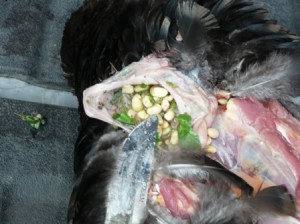
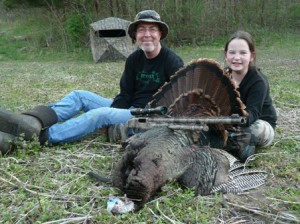 Forage soybeans can produce high quality food for 11 months, from one planting and one expense. I was reminded of the huge advantages of forage soybeans while I was cleaning a gobbler my oldest daughter, Raleigh (age 12), harvested this past weekend. After removing the gobbler’s breast, I opened the crop to see what he had been eating. We call this scouting from the skinning shed. By seeing what critters are currently eating, a hunter can accurately predict where other members of the same species will be consuming the next few days. Raleigh’s turkey was full of soybean seeds! Using this M.R.I. (Most Recent Information), I took my youngest daughter, Rae (age 9) hunting that afternoon. We selected a location overlooking a forage soybean field that had been planted the previous spring. She harvested a mature gobbler there that afternoon.
Forage soybeans can produce high quality food for 11 months, from one planting and one expense. I was reminded of the huge advantages of forage soybeans while I was cleaning a gobbler my oldest daughter, Raleigh (age 12), harvested this past weekend. After removing the gobbler’s breast, I opened the crop to see what he had been eating. We call this scouting from the skinning shed. By seeing what critters are currently eating, a hunter can accurately predict where other members of the same species will be consuming the next few days. Raleigh’s turkey was full of soybean seeds! Using this M.R.I. (Most Recent Information), I took my youngest daughter, Rae (age 9) hunting that afternoon. We selected a location overlooking a forage soybean field that had been planted the previous spring. She harvested a mature gobbler there that afternoon.
By using the technique of scouting from the skinning shed, I was able to confirm that Eagle Seed forage soybeans provide high quality food (forage with high quality protein during the summer and seeds with high quality energy during the winter) at least 11 months throughout the year.
If I was asked the same question at a conference again today, I would have a much better idea of what the “magic bean” is for wildlife food plots. It is a forage soybean that also produces gads of grain.
Growing Deer together,
Grant
North Creek Turkey Hunting
I returned from turkey hunting in Knox County, IL early this morning (2 am). It was a very enjoyable hunt! Even though it was raining and cold my hunting partner, Michael Engelmeyer, harvested a mature tom that responded to his calls. I also had some birds respond. Two jakes approached within a few yards of my blind the last morning of the hunt. Then, about 11 am (turkey hunting is only legal till 1pm each day during season in IL) a mature bird came into view about 80 yards away. He had been gobbling in response to my calls. Blake, the GrowingDeer.tv editor, was with me and we were confident the tom would close the gap. After he strutted at the crest of the hill so long Blake turned off the camera, the tom started our way. He took a right turn rather than coming straight at about 40 yards out. I wasn’t worried as the occasional gobble confirmed he hadn’t ventured far out of our sight. At 12:40 pm I did begin to doubt he would offer a shot. At 12:55 he appeared at 38 yards… That was an easy shot with my shotgun – that was in gun safe in Missouri. 38 yards is a bit far for me to shoot at a turkey with a bow in windy conditions.
I pulled the release off at 1 pm and joined Michael to celebrate his success! There are those that joke about eating tag soup – a term describing what a hunter has to eat when they didn’t harvest a critter and all he has to eat is his tag. I’ve came home with tag soup many times in my hunting career. However, my experience tag has almost always been full after a hunt. I learned more about a beautiful property (North Creek). Michael shared with me some of his late season turkey tactics and I observed several bucks with velvet antlers above their ears already! I hope you have the opportunity to fill your experience tag soon!
Growing Deer together,
Grant
Reviewing Management Practices
I like to review the success or failure of all management practices implemented on my projects. Each hunting season is a management practice that produces quantifiable results (harvests) that can be compared year to year or from property to property.
We harvested six mature gobblers and one jake (GDTV 23). We had more opportunities that did not end with a harvest for various reasons — the camera and shooter weren’t lined up together, etc. Every hunter except one saw mature toms in harvest range. Three hunters harvested their first bird. Any way you measure, it was a great turkey season at The Proving Grounds! However, other folks in our county didn’t share in our success. The Proving Grounds is split by the Stone/Taney county line. The following data indicates that that turkey population in Taney County is down.

However, the establishment of good food, cover, and predator control helped build a great turkey population. It was an oasis for wildlife and for hunters. We enjoyed a fabulous turkey season at The Proving Grounds! The good news is — you too can create your own oasis by implementing good habitat and population management programs and strategies.
Growing Deer (and turkeys) together,
Grant
Turkey!
Another fabulous morning at The Proving Grounds! Scott Smith with Trophy Rock killed a 3 year old gobbler (24.6 pounds, 10 ¼” beard, and 1 ¼” spurs). Good habitat management programs directed at improving the food, cover, and water resources here at The Proving Grounds is paying huge dividends! Remember, this area is known for its extremely poor soils. A BC or PY buck has never been recorded for these counties (The Proving Grounds is split across county lines).
Big gobblers in the spring usually indicate big bucks in the fall unless a drought occurs. After filming several mature gobblers this spring, I’m extremely excited about deer hunting this fall.
Growing Deer together,
Grant
A Busy Turkey Season
Later today I will be giving a presentation to the leadership of the hunting department for Bass Pro Shops. I’m working on the final touches now and hoping to get back out in the turkey woods tomorrow morning. I’ve noticed some of my crops are already germinating and will be checking on them also. I have an Illinois turkey tag for next week. I hope to have enough time to head that way and chase some Knox County birds at North Creek Preserve.
Growing Deer together,
Grant
More Gobbler Action
Like myself, Brad believes in sharing his love of hunting with today’s youth. Brad made time to take Justin out on a youth hunt last weekend. Justin’s jake was 15 lbs.
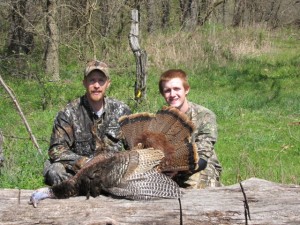
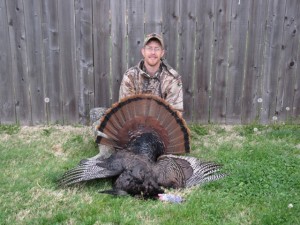
An avid hunter, Brad never has trouble waking up early to get out. Yesterday his dedication paid off. Brad headed out early in the morning and waited quietly until he heard gobbles over in the distance. He was able to enjoy success with a 21 lb, 10 1/4” beard, 9/16” spurs gobbler.
Growing Deer together,
Grant



